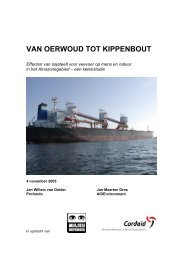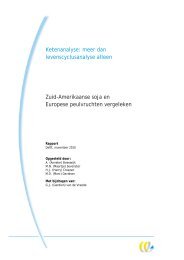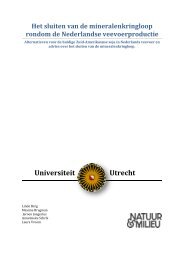Relation between expansion of soy plantations and deforestation
Relation between expansion of soy plantations and deforestation
Relation between expansion of soy plantations and deforestation
You also want an ePaper? Increase the reach of your titles
YUMPU automatically turns print PDFs into web optimized ePapers that Google loves.
<strong>Relation</strong> <strong>between</strong><br />
<strong>expansion</strong> <strong>of</strong> <strong>soy</strong> <strong>plantations</strong><br />
<strong>and</strong> <strong>deforestation</strong><br />
UNDERSTANDING THE DYNAMICS<br />
EXECUTIVE SUMMARY<br />
Forests Work Group<br />
Brazilian Forum <strong>of</strong> NGOs<br />
<strong>and</strong> Social Movements<br />
for the Environment <strong>and</strong> Development
This document was prepared through the initiative <strong>of</strong> the Forests Working Group <strong>of</strong> the<br />
Brazilian Forum <strong>of</strong> NGOs <strong>and</strong> Social Movements for Environment <strong>and</strong> Development<br />
(FBOMS).<br />
The FBOMS Forests WG is coordinated by Adriana Ramos, from the Socioenvironmental<br />
Institute (Instituto Socioambiental). Friends <strong>of</strong> the Earth - Brazilian Amazonia <strong>and</strong> Imaflora<br />
act as focal point on the issue <strong>soy</strong> vs. forests within the WG, being the organizations<br />
responsible for formulating <strong>and</strong> publishing this document. The following organizations<br />
<strong>and</strong> networks make up the Forests WG, representing a total <strong>of</strong> over 700 institutions:<br />
- Friends <strong>of</strong> the Earth - Brazilian Amazonia<br />
- Center for Alternative Agriculture in Northern Minas (CAA)<br />
- Amazonian Workers Center - CTA/AC<br />
- CUT Environment Commission (Trade Unions)<br />
- Pastoral L<strong>and</strong> Commission - CPT Xingu<br />
- Federation <strong>of</strong> Social Assistance <strong>and</strong> Educational Agencies - FASE<br />
- CEBRAC Foundation<br />
- Pro-Nature Foundation - Funatura<br />
- Vitoria Amazonica Foundation - FVA<br />
- SOS Atlantic Rainforest Foundation<br />
- Greenpeace<br />
- Amazon Work Group - (GTA in Portuguese) (network <strong>of</strong> 430 local organizations)<br />
- Institute for Forest Management <strong>and</strong> Certification - IMAFLORA<br />
- Institute <strong>of</strong> Man <strong>and</strong> the Environment <strong>of</strong> Amazonia - IMAZON<br />
- Institute for Environmental Research <strong>of</strong> Amazonia - IPAM<br />
- Socioenvironmental Institute - ISA<br />
- Institute for Society, Population <strong>and</strong> Nature (ISPN)<br />
- The Greens - Social Ecology Movement<br />
- Atlantic Rainforest NGO Network (network <strong>of</strong> 256 local organizations)<br />
- The Nature Conservancy - TNC<br />
- Vitae Civilis - Institute for Development, Environment <strong>and</strong> Peace<br />
- WWF Brazil<br />
1
This document does not represent positions <strong>of</strong> the Forests WG nor <strong>of</strong> its members<br />
individually. It is a research document that seeks to <strong>of</strong>fer inputs for discussion <strong>and</strong> greater<br />
underst<strong>and</strong>ing <strong>of</strong> the theme by public <strong>and</strong> private decision-makers, reporters <strong>and</strong> observers,<br />
as well as a basis for individual initiatives on the theme by member organizations <strong>of</strong> the<br />
Forests WG.<br />
This document was prepared with financial support from:<br />
- International Institute for Education in Brazil (IIEB)<br />
- USAID<br />
- Friends <strong>of</strong> the Earth - Brazilian Amazonia<br />
<strong>and</strong> institutional collaboration from:<br />
- Socioenvironmental Institute (ISA)<br />
- Instituto Centro de Vida<br />
- Imaflora<br />
- WWF-Brazil<br />
Supervision <strong>and</strong> Executive Summary: Weber Amaral <strong>and</strong> Roberto Smeraldi (Friends <strong>of</strong><br />
the Earth) Research <strong>and</strong> Preparation: Chapter 1 - Carlos Perez; Chapter 2 - André Lima<br />
(Socio-Environmental Institute), Salatiel Alves de Araújo, Jean Carlo Figueira; Chapter 3 -<br />
Sílvio Frozini de Barros Ferraz <strong>and</strong> Weber Amaral.<br />
Contributors: Ana Cristina Barros (TNC), Ilan Kruglianskas (WWF), Maurício Galinkin<br />
(CEBRAC Foundation), José Arnaldo de Oliveira (AWG), Luiz Fern<strong>and</strong>o Guedes Pinto<br />
(Imaflora), Adriana Ramos (ISA), Cláudia Azevedo Ramos (IPAM), Sérgio Guimarães<br />
(ICV), Cristine Branco, Daniela Kawakami, Luciane Simões, Maurício Araújo, Denise<br />
Conselheiro (Friends <strong>of</strong> the Earth), Vítor Ozaki.<br />
Photos: Salatiel Alves de Araújo, Jean Carlo Figueira.<br />
Contacts:<br />
Friends <strong>of</strong> the Earth - Brazilian Amazonia<br />
Rua Bento de Andrade, 85<br />
04503-010 São Paulo - SP<br />
Tel.: (11) 3887-9369<br />
Fax: (11) 3884-2795<br />
E-mail: info@amazonia.org.br<br />
2
Introduction<br />
The Forests Working Group <strong>of</strong> the Brazilian Forum <strong>of</strong> NGOs <strong>and</strong> Social Movements<br />
initiated a discussion on <strong>soy</strong> <strong>and</strong> <strong>deforestation</strong> in October 2003, when the organizations<br />
Friends <strong>of</strong> the Earth - Brazilian Amazonia <strong>and</strong> Imaflora became focal points on this<br />
subject. The work moved forward in a meeting held in February 2004 in Brasilia. Minimum<br />
Criteria on Soy Cropping in Forest Areas were approved (presented in attachment to<br />
this document). The purpose <strong>of</strong> these criteria is only to act as a suggested minimum<br />
purchasing policy for commercial <strong>soy</strong>bean buyers regarding the origin <strong>of</strong> their products<br />
in forest areas. They are not to be confused with other broader criteria (on sustainability,<br />
agricultural practices in general, etc.) under discussion in different national <strong>and</strong><br />
international forums, including with participation <strong>of</strong> FBOMS. In June 2004, the Forests<br />
WG met with the Minister <strong>of</strong> Agriculture, Roberto Rodrigues, <strong>and</strong> presented the<br />
abovementioned minimum criteria. The Minister suggested that certain studies be<br />
conducted on the relation <strong>between</strong> <strong>soy</strong> cropping <strong>and</strong> <strong>deforestation</strong>, in order to provide a<br />
foundation for the proposed criteria. In September <strong>and</strong> in November 2004, the Forests<br />
WG conducted two more two-day seminars on the theme, even discussing preliminary<br />
studies that are the bases for this document. In December 2004, the WG met again with<br />
Minister Roberto Rodrigues <strong>and</strong> representatives <strong>of</strong> the private sector to share <strong>and</strong> discuss<br />
the preliminary results <strong>of</strong> this study, the purpose <strong>of</strong> which is to provide inputs for discussion<br />
<strong>and</strong> in no wise represents a position <strong>of</strong> Forests WG or <strong>of</strong> its members.<br />
3
EXECUTIVE SUMMARY<br />
This document presents the main results <strong>and</strong> conclusions <strong>of</strong> three studies<br />
conducted through the initiative <strong>of</strong> the Forests WG <strong>of</strong> the Brazilian Forum <strong>of</strong> NGOs <strong>and</strong><br />
Social Movements for the Environment <strong>and</strong> Development (FBOMS) on the relation<br />
<strong>between</strong> <strong>expansion</strong> <strong>of</strong> <strong>soy</strong> <strong>plantations</strong> <strong>and</strong> <strong>deforestation</strong>. The studies focused only on<br />
issues related to <strong>expansion</strong> <strong>of</strong> area under cultivation, <strong>and</strong> did not analyze the relation<br />
<strong>between</strong> <strong>deforestation</strong> <strong>and</strong> the processing <strong>of</strong> <strong>soy</strong>beans (the use <strong>of</strong> charcoal, for example)<br />
or transportation infrastructure (direct impacts <strong>of</strong> road building, etc.). The first part <strong>of</strong> the<br />
document presents the context <strong>and</strong> multiple variables relating the <strong>deforestation</strong> <strong>and</strong><br />
<strong>expansion</strong> <strong>of</strong> the agricultural frontier in Amazonia. The second part <strong>of</strong> the document<br />
presents the results <strong>of</strong> a detailed <strong>and</strong> unprecedented survey on current l<strong>and</strong> use in the<br />
largest illegally deforested areas in the State <strong>of</strong> Mato Grosso in the years from 2001 to<br />
2003. Lastly, the third part <strong>of</strong> the document presents the results from correlations analyses<br />
conducted by this project <strong>between</strong> <strong>soy</strong> <strong>expansion</strong>, <strong>deforestation</strong> <strong>and</strong> ranching in the<br />
most intense colonization regions <strong>of</strong> Brazilian Amazonia, providing inputs for the<br />
preparation <strong>of</strong> scenarios on <strong>soy</strong> <strong>expansion</strong> based on the main constraining <strong>and</strong><br />
conditioning factors studied.<br />
1. Context<br />
One <strong>of</strong> the consequences <strong>of</strong> the process <strong>of</strong><br />
<strong>expansion</strong> <strong>of</strong> the agricultural frontier in the Mid-<br />
West <strong>and</strong> North regions is concentration <strong>of</strong> l<strong>and</strong>ownership,<br />
income <strong>and</strong> productive systems - large<br />
cattle ranches <strong>and</strong> mechanized monocultures (in<br />
the case <strong>of</strong> <strong>soy</strong>) - with the subordination <strong>of</strong><br />
cultural <strong>and</strong> productive patterns <strong>of</strong> regional <strong>and</strong><br />
local communities to the pattern practiced by the<br />
new social actors, usually immigrants from other<br />
regions, with access to capital <strong>and</strong> technology.<br />
This process has led to an increase in the<br />
displacement <strong>of</strong> small holders, due to social<br />
conflicts or purchase <strong>of</strong> their plots, resulting in<br />
new local frontiers <strong>and</strong> increased <strong>deforestation</strong>.<br />
In areas <strong>of</strong> <strong>soy</strong> <strong>expansion</strong>,<br />
pr<strong>of</strong>itability <strong>of</strong> ranching <strong>and</strong><br />
later transformation or sale <strong>of</strong><br />
l<strong>and</strong> for intensive agriculture<br />
indicates both to the initial<br />
agents as well as to ranchers,<br />
that <strong>deforestation</strong> <strong>and</strong> forest<br />
conversion into pasture makes<br />
good business sense. If said<br />
pr<strong>of</strong>its did not exist, there would<br />
be no interest in appropriating<br />
or purchasing converted l<strong>and</strong>s<br />
<strong>and</strong> <strong>deforestation</strong> would<br />
certainly occur at a much<br />
slower pace.<br />
Property rights in all stages <strong>of</strong> the <strong>deforestation</strong> process are ensured by the physical<br />
occupation <strong>of</strong> the l<strong>and</strong>, presence is <strong>of</strong>ten much more important than any deed document,<br />
encouraging the activity <strong>of</strong> speculators (grileiros) or squatters to occupy l<strong>and</strong>s <strong>and</strong> ensure<br />
transfer to new actors who are adverse to relatively larger risks, even though they be low.<br />
4
There is a trend to increase technology use <strong>and</strong> pr<strong>of</strong>essionalization <strong>of</strong> ranching<br />
production, generating real perspectives <strong>of</strong> pr<strong>of</strong>it that encourage agents with different<br />
roles. Some tend to be speculators, with no long term interest or commitment to production<br />
per se (at most, they capitalize themselves temporarily by logging the trees), while others<br />
are capitalized <strong>and</strong> pr<strong>of</strong>essional entrepreneurs from the consolidated frontier, with a<br />
direct relation to the formal economy. Those actors without capital, to date not only have<br />
been excluded from these processes, but also tend to be displaced to peripheral areas,<br />
where they contribute to the opening <strong>of</strong> new mobile frontiers or exp<strong>and</strong> the reach <strong>of</strong><br />
those already in existence.<br />
2. Illegal <strong>deforestation</strong> in Mato Grosso <strong>and</strong> evolution <strong>of</strong> l<strong>and</strong> use<br />
Cropping cycles in recently-deforested areas in the<br />
State <strong>of</strong> Mato Grosso are becoming shorter. This<br />
process is most evident in regions that already have<br />
a relatively consolidated agricultural frontier, access<br />
The area <strong>of</strong> Mato Grosso<br />
with <strong>soy</strong>bean plantation<br />
increased 400% in the<br />
last ten years. Plantation<br />
to infrastructure <strong>and</strong> flat topography. There is began in central<br />
evidence that the term <strong>of</strong> roughly 5 years <strong>between</strong><br />
<strong>deforestation</strong> <strong>and</strong> mechanization - estimated by<br />
most observers - is shortening to approximately 2-3<br />
savannah forests <strong>and</strong><br />
migrated to the north<br />
some 500 km, shifting the<br />
years. The time in 20% <strong>of</strong> the cases analyzed was <strong>of</strong> agricultural frontier.<br />
only one year.<br />
During the same period,<br />
the State’s deforested<br />
area symmetrically <strong>and</strong><br />
progressively increased in dimension by 133%, according to state government data.<br />
In Mato Grosso, the FBOMS Forests WG study analyzed the areas where the<br />
greatest illegal <strong>deforestation</strong> occurred in the years 2001, 2002 <strong>and</strong> 2003, including l<strong>and</strong><br />
use evolution <strong>and</strong> frequency <strong>of</strong> conversion from one l<strong>and</strong> use to another. The study analyzed<br />
31 <strong>of</strong> the 65 largest illegal <strong>deforestation</strong>s <strong>of</strong> the period (above 1,350 hectares) located<br />
along the BR-163 highway, in 20 municipalities in five micro-regions, as follows:<br />
−<br />
−<br />
−<br />
−<br />
Micro-Region <strong>of</strong> Alto Teles Pires (in the municipalities <strong>of</strong> Nova Ubiratã, Nobres,<br />
Sorriso, Nova Mutum, Tapurah <strong>and</strong> Lucas do Rio Verde);<br />
Micro-Region <strong>of</strong> Arinos: (in the municipalities <strong>of</strong> Tabaporã, Nova Maringá <strong>and</strong> Porto<br />
dos Gaúchos);<br />
Micro-Region <strong>of</strong> Colider: (in the municipality <strong>of</strong> Nova Canaã do Norte);<br />
Micro-Region <strong>of</strong> Paranatinga (in the municipalities <strong>of</strong> Paranatinga <strong>and</strong> Gaúcha do<br />
Norte)<br />
5
−<br />
Micro-Region <strong>of</strong> Sinop (in the municipalities <strong>of</strong> Cláudia, Itaúba, União do Sul, Sinop,<br />
Marcelândia, Vera, Feliz Natal <strong>and</strong> Santa Carmem);<br />
All <strong>of</strong> the 31 properties that underwent <strong>deforestation</strong> were initially analyzed using satellite<br />
images, then verified through overflights <strong>and</strong> in certain cases, also visited on the ground.<br />
In table 1 below, the main vegetation types observed are presented; based on frequency<br />
observed, indicating that 55% <strong>of</strong> the areas are located in dense forests <strong>and</strong> the rest in<br />
areas with mixed occurrence <strong>of</strong> dense, transition <strong>and</strong> savannah forests.<br />
Table 1. Vegetation types on the properties studied<br />
Vegetation types present on the properties<br />
where <strong>deforestation</strong> under<br />
analysis occurred<br />
Number <strong>of</strong><br />
observations<br />
Dense Forest 17<br />
Dense Forest <strong>and</strong> Transition Forest 2<br />
Transition Forest 7<br />
Savannah Forest <strong>and</strong> Transition Forest 3<br />
Dense Forest <strong>and</strong> Savannah Forest 1<br />
Dense Forest, Tansition Forest<br />
1<br />
<strong>and</strong> Savannah Forest<br />
Total 31<br />
6
Table 2 below presents the evolution <strong>of</strong> l<strong>and</strong> use per type <strong>of</strong> use (ranching, rice,<br />
pearl millet, <strong>soy</strong> <strong>and</strong> other uses) in October 2004, according to frequency observed.<br />
Table 2. L<strong>and</strong> use (in October 2004) in areas analyzed <strong>of</strong> large-scale <strong>deforestation</strong>s,<br />
per reference year.<br />
Year <strong>of</strong><br />
Deforestation<br />
2001<br />
2002<br />
2003<br />
Current Use<br />
Nº<br />
Observations<br />
Ranching<br />
Rice<br />
Soy 4<br />
Millet<br />
Ranching 3<br />
Rice 3<br />
Soy 1<br />
Millet 1<br />
Ranching 5<br />
Rice 6<br />
Soy 7<br />
Millet<br />
Not in Use 1<br />
Total <strong>of</strong> observations 31<br />
3. Soy cropping displacing ranching <strong>and</strong> scenarios <strong>of</strong> exp<strong>and</strong>ed cropping<br />
The correlation analyses <strong>between</strong> <strong>expansion</strong> <strong>of</strong><br />
<strong>soy</strong> cropping <strong>and</strong> <strong>deforestation</strong> rates on a<br />
municipal scale show that there is an indirect<br />
relation <strong>between</strong> the two phenomena, indicating<br />
that <strong>soy</strong> cropping is a <strong>deforestation</strong> factor, while<br />
not the only one. Indications exist that its<br />
<strong>expansion</strong> drives <strong>deforestation</strong> towards new<br />
pioneer areas, mainly by displacing ranching.<br />
Furthermore, future scenarios point to an<br />
increased <strong>expansion</strong> <strong>of</strong> <strong>soy</strong> cropping due to the<br />
availability <strong>of</strong> l<strong>and</strong> <strong>and</strong> infrastructure.<br />
Analyses <strong>of</strong> the evolution<br />
<strong>of</strong> the areas under <strong>soy</strong> plantation<br />
in the states <strong>of</strong> Mato Grosso,<br />
Rondônia, Pará, Tocantins <strong>and</strong><br />
Maranhão were conducted,<br />
where the most <strong>of</strong> the <strong>soy</strong><br />
producing regions from the<br />
center-north regions <strong>of</strong> Brazil are<br />
located. In parallel, <strong>deforestation</strong><br />
that occurred during the period<br />
from 200-2002 was also<br />
analyzed, seeking to identify<br />
7
elations <strong>between</strong> the increase <strong>of</strong> area with <strong>soy</strong> <strong>plantations</strong> <strong>and</strong> <strong>deforestation</strong> rates. An<br />
attempt was also made to analyze trends in the areas considered as susceptible to<br />
<strong>deforestation</strong>. Analyses were conducted based on <strong>of</strong>ficial data from agencies such as<br />
EMBRAPA, CONAB, INPE, MMA, DNIT <strong>and</strong> BNDES, in addition to contextual information<br />
published by member research institutions <strong>of</strong> the Forests WG. The study also aimed at<br />
producing inputs for future preparation <strong>of</strong> <strong>soy</strong> <strong>expansion</strong> scenarios in function <strong>of</strong> elements<br />
<strong>of</strong> infrastructure already in existence <strong>and</strong> that forecast on the short-term.<br />
Certain elements clearly indicate the fact that <strong>soy</strong> cropping displaces ranching to<br />
new areas, with a likely effect <strong>of</strong> additional <strong>deforestation</strong>. This may be seen by the<br />
phenomenon <strong>of</strong> reduced cattle herds in the main <strong>soy</strong>-producing municipalities, nonetheless,<br />
the herds increase in the peripheral regions, especially (in the case <strong>of</strong> Mato Grosso) to the<br />
municipalities in regions along the mobile frontier.<br />
Several variables to quantify this process were analyzed, especially in the state <strong>of</strong><br />
Mato Grosso. The area planted in the year 2000 was studied (A_<strong>soy</strong>2000), the increase<br />
in area planted for <strong>soy</strong> cropping in the municipalities (Inc_<strong>soy</strong>0102) <strong>and</strong> the <strong>deforestation</strong><br />
rates observed for the same period (Rate_defor0102). The analyses included correlation<br />
studies <strong>between</strong> said variables, for the purpose <strong>of</strong> identifying any relation <strong>between</strong> <strong>soy</strong><br />
<strong>expansion</strong> <strong>and</strong> the <strong>deforestation</strong> process.<br />
Results indicate that <strong>deforestation</strong> rates are positively correlated (50%) to the<br />
increase in <strong>soy</strong> cropping <strong>and</strong> this correlation is extremely significant from the statistical<br />
point <strong>of</strong> view (>99% probability). Another element is that the increase in area planted with<br />
<strong>soy</strong>beans in the State seems to occur in municipalities that are already <strong>soy</strong> producers,<br />
with large areas already deforested, <strong>and</strong> an ongoing process <strong>of</strong> <strong>deforestation</strong>. Analyzing<br />
the relation <strong>between</strong> the rates <strong>of</strong> increase in the cattle herds during the period with the<br />
other variables, one notes that there is a negative correlation <strong>between</strong> area planted for<br />
<strong>soy</strong> cropping <strong>and</strong> herd increase, which means that the number <strong>of</strong> head <strong>of</strong> cattle has<br />
decreased in the municipalities with large <strong>soy</strong> <strong>plantations</strong> (Table 4).<br />
Table 4. Correlation analysis among the variables: <strong>soy</strong> cropping area in 2002, increase<br />
in <strong>soy</strong> plantation <strong>between</strong> 2000 <strong>and</strong> 2002, average <strong>deforestation</strong>, total <strong>deforestation</strong><br />
<strong>and</strong> cattle herd increase rate. Levels <strong>of</strong> significance obtained are in parentheses,<br />
the closer to zero, the more significant the results obtained.<br />
A_Soy_2000 Inc_Soy_01/02 Defor_Tot03 Rt_defor01/02<br />
Inc_Soy01/02 0.511<br />
(0.000)<br />
Defor_Tot03 0.067 0.430<br />
(0.653) (0.003)<br />
Rt_defor01/02 0.034 0.501 0.780<br />
(0.823) (0.000) (0.000)<br />
Rt_inc_Hrd00/03 -0.271 -0.078 0.180 0.188<br />
(0.066) (0.602) (0.225) (0.205)<br />
8
The relation <strong>between</strong> the increase in area with <strong>soy</strong> planted <strong>and</strong> the decrease in<br />
ranching activities became even more evident when data on variation <strong>of</strong> the cattle herd in<br />
the state <strong>of</strong> Mato Grosso is presented spatially (Figure 2). One clearly sees on the map a<br />
reduction <strong>of</strong> ranching activities in the central section <strong>of</strong> the state (especially in the main<br />
centers <strong>of</strong> <strong>soy</strong> cropping <strong>expansion</strong>) <strong>and</strong> its expressive increase in the northern region,<br />
displaying its dislocation <strong>and</strong> explaining the pressure being placed on the dense forest.<br />
Figure 2 – Variation <strong>of</strong> cattle herd in Mato Grosso <strong>between</strong> the years 2000 <strong>and</strong><br />
2003. (Source: IBGE)<br />
4. Soy cropping <strong>expansion</strong> scenarios<br />
The partial analysis <strong>of</strong> constraining factors <strong>and</strong> stimuli to the future definition <strong>of</strong> <strong>soy</strong><br />
cropping <strong>expansion</strong> scenarios for the region demonstrate that the main corridors available<br />
for transportation <strong>of</strong> the crop - Porto Velho-Itacoatiara <strong>and</strong> Porto de Itaqui – make large<br />
areas surrounding the highways <strong>and</strong> secondary roads susceptible to conversion to <strong>soy</strong><br />
cropping. The zone <strong>of</strong> influence <strong>of</strong> infrastructure is defined in function <strong>of</strong> the cost/ difficulty<br />
<strong>of</strong> access ratio <strong>and</strong> the economic return <strong>of</strong> the activity.<br />
9
A 100km zone around the existing roads includes the largest expanses <strong>of</strong> areas<br />
already deforested yet not currently used for <strong>soy</strong> cropping in the north <strong>of</strong> Mato Grosso, the<br />
central region <strong>of</strong> Rondonia, the eastern portion <strong>of</strong> Pará, the north <strong>of</strong> Tocantins <strong>and</strong> southern<br />
Maranhão. The forested areas most susceptible to <strong>deforestation</strong> within the same zone <strong>of</strong><br />
influence are the transition areas <strong>of</strong> Savannah to Forest, principally located in southern<br />
Rondonia, midwest <strong>of</strong> Mato Grosso <strong>and</strong> eastern Mato Grosso (Table 5). The table below<br />
points toward some preliminary estimates <strong>of</strong> <strong>soy</strong> cropping <strong>expansion</strong>, to be validated by<br />
including other potentially important states (such as Amazonas <strong>and</strong> Roraima) <strong>and</strong> by the<br />
use <strong>of</strong> different variables in the infrastructure availability scenarios.<br />
Table 5 – Size <strong>of</strong> areas with <strong>soy</strong> plantation <strong>and</strong> with other uses, potential area for<br />
plantation <strong>and</strong> estimated allocation <strong>of</strong> new areas <strong>of</strong> <strong>soy</strong> plantation in five states<br />
(amounts in km 2 ).<br />
State<br />
RO<br />
PA<br />
TO<br />
MA<br />
MT<br />
Area<br />
Deforested 1<br />
57157<br />
91210<br />
29841<br />
39293<br />
156720<br />
Area<br />
Soy 2<br />
595<br />
268<br />
2436<br />
3425<br />
51488<br />
Other<br />
Uses<br />
56562<br />
90942<br />
27405<br />
35868<br />
105232<br />
Potential<br />
State 3<br />
100000<br />
10000<br />
8000<br />
10000<br />
400000<br />
Estimated<br />
Area (2014)<br />
37708<br />
10000<br />
8000<br />
10000<br />
105000<br />
Increase<br />
forecast<br />
37113<br />
9732<br />
5564<br />
6575<br />
53512<br />
Total<br />
374221<br />
58212<br />
316009<br />
528000<br />
170708<br />
112496<br />
Source: 1 - INPE/PRODES (2004); 2 – IBGE (2004), 3 – Adapted from Bickel, U. & J.M.<br />
Dros (2003).<br />
5. Conclusions<br />
a) Deforestation processes are complex <strong>and</strong> involve multiple factors, in different scales <strong>of</strong><br />
time <strong>and</strong> space. Although the spatial <strong>and</strong> temporal dimensions <strong>of</strong> the mobile <strong>deforestation</strong><br />
frontier were thoroughly studied in the late 1980s <strong>and</strong> early 1990s, <strong>soy</strong> cropping currently<br />
adds additional complexity factors: potentializes the scale <strong>of</strong> the <strong>deforestation</strong> process,<br />
increases the speed <strong>of</strong> changes in l<strong>and</strong> use from one crop to another <strong>and</strong> drives the<br />
ranching frontier, maintaining at times a direct - <strong>and</strong> at others indirect - relation with<br />
<strong>deforestation</strong>.<br />
b) There is a clear correlation <strong>between</strong> <strong>deforestation</strong> rates <strong>and</strong> <strong>soy</strong> cropping <strong>expansion</strong><br />
in the areas analyzed within the Amazon region. Nonetheless, the factors that affect<br />
10
this correlation must be more thoroughly studied, regarding the speed (temporal<br />
dimension) <strong>and</strong> direction (spatial dimension) <strong>of</strong> <strong>deforestation</strong>.<br />
c) The forecast for 2014 is that the area planted with <strong>soy</strong>beans in the states <strong>of</strong> Mato<br />
Grosso, Rondônia, Pará, Maranhão <strong>and</strong> Tocantins may be as much as tripled in function<br />
<strong>of</strong> existing trends, this is, however, subject to alterations, depending on other external<br />
market factors. A large part <strong>of</strong> the new areas shall most likely occur in the states <strong>of</strong> Mato<br />
Grosso <strong>and</strong> Rondônia. Nonetheless, such forecasts may also be altered in function <strong>of</strong> the<br />
<strong>expansion</strong> <strong>of</strong> areas planted in other states <strong>of</strong> Amazonia (such as Amazonas <strong>and</strong> Roraima)<br />
or in the Northeast. One must also note that the environmental <strong>and</strong> social impacts will also<br />
vary significantly according to the situation <strong>of</strong> each state or sub-region, <strong>and</strong> these must be<br />
studied on a case-by-case basis, in due detail <strong>and</strong> properly contextualized.<br />
d) The current lack <strong>of</strong> data, surveys <strong>and</strong> research on the subject <strong>of</strong> this study leads to the<br />
conclusion that it is urgently necessary that the initial work begun by the FBOMS Forests<br />
WG be exp<strong>and</strong>ed <strong>and</strong> conducted in greater detail, with primary surveys in other subregions<br />
<strong>and</strong> trends analyses with the major variables suggested in this study. Said studies<br />
may be conducted both by members <strong>of</strong> the Forests WG as well as by government research<br />
centers, Universities <strong>and</strong> other institutions interested in these processes <strong>and</strong> problems <strong>of</strong><br />
relevance to the country.<br />
11












